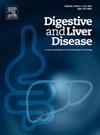Reintegration into working life after Liver Transplantation: are there predictors of unemployment?
IF 3.8
3区 医学
Q1 GASTROENTEROLOGY & HEPATOLOGY
引用次数: 0
Abstract
Background
The reintegration of liver transplant (LT) recipients into the workforce remains a key objective, yet specific recommendations to guide this process are still lacking. The BRIC-2022-ID25 project explores how liver disease and transplantation affect employability, analyzing the interplay of clinical, social, and occupational variables before and after LT, with the goal of improving return-to-work outcomes.
Methods
In collaboration with the occupational medicine department, we enrolled all patients who underwent LT at our center between 2018 and 2023, aged 18 to 68 years, who were not retired prior to LT. Participants completed the WHODAS 2.0 (World Health Organization Disability Assessment Schedule) and Work Ability Index (WAI) questionnaires, with results merged with clinical and occupational data from both pre- and post-LT follow-up. Patients were interviewed between January and December 2024. Univariate and multivariate analysis were performed following 3 outcomes: 1) Return to work, 2) Current work ability (WAS) and total WAI, 3) Disability score (WHODAS).
Results
From 2018 to 2023 918 LT were performed; 163/918 (18%) were excluded for age, 77/918 (8%) because they died before the study, 161/918 (17%) already retired before transplant, 55/918 (6%) because never worked before and after LT for personal choice; 181/918 (20%) refused to participate or were excluded for other reasons. 281/918 (31%) agreed to participated. The 83% of partecipants had cirrhosis (viral 40%; alcoholic 15%; 42% with hepatocellular carcinoma – HCC), 11% hepatic/hepatorenal polycistosis, 6.4% other indication to LT. 8% received a combined LT (mostly kidney). The mean age at interview was 55 years (range 24-68), with 65% males and an average of 44 months between LT and the interview. Notably, 55% had a middle-school education, while 25% had a university degree. 90% were Italian; 72% lived in the same region of the transplant center. 66% identified as caregiver his/her partner, 30% another relative/parents. Outcome 1: the overall return-to-work rate was 0.36 (95% CI: 0.30–0.41) at 6 months, reaching a maximum of 0.64 (95% CI: 0.57–0.70) at 36 months. Men return to work more rapidly and in a greater proportion than women (Log-Rank test, p-value < 0.001). Post-LT, 39% were unemployed, with 64% indicating health issues as a barrier to their job search. At univariate analysis, significant correlations were found between unemployment and factors such as age >59 years (p=0.049), having a caregiver outside the household (p=0.01), middle-school education (p=0.04), a longer waiting list time (p=0.02). At multivariate analysis, male sex (OR 3.6, p=0.001), Age > 59 y (OR 0.015, p=0.01), university degree (OR 5.6, P=0.006), caregiver outside the household (OR 0.3, p=0.001) were independent predictor for return-to-work.Outcome 2: low self-assessment of work ability (WAS) correlated with age >59 years old (p=0.01), both active (p=0.01) and previous (p=0.003) smoking, lower education levels (p=0.04). At multivariate analysis, smoking (p=0.005) and educations levels (p=0.047) were confirmed. The total WAI score (applicable only in working patients) was higher in Italian patients (p=0.011) and lower in those with polycistosis (p=0.008). At multivariate analysis, age > 59 years (p=0.01), lower education levels (p=0.036) were identified as independent factors of low WAI score.Outcome 3: Poorer disability scores (WHODAS) were associated with non-Italian nationality (p=0.008), alcohol use disorder (p=0.04), and longer hospital stays after LT (p=0.03). At multivariate analysis, male sex was associated to better WHODAS score (p=0.01), while the other variables were not confirmed.
Conclusions
Our study revealed a 39% unemployment rate following LT, with health status affecting 64% of cases. Factors such as caregiving responsibilities, education level, nationality, age, and complications significantly impact work ability. Enhanced efforts are needed to ensure equitable employment opportunities for transplant recipients.
肝移植后重返工作生活:是否有失业的预测因素?
背景:肝移植(LT)受者重新融入劳动力市场仍然是一个关键目标,但指导这一过程的具体建议仍然缺乏。金砖国家-2022- id25项目探讨肝脏疾病和移植如何影响就业能力,分析肝脏移植前后临床、社会和职业变量的相互作用,目的是改善重返工作岗位的结果。方法与职业医学部合作,纳入2018年至2023年间在本中心接受肝移植的所有患者,年龄在18岁至68岁之间,在肝移植前未退休。参与者完成WHODAS 2.0(世界卫生组织残疾评估表)和工作能力指数(WAI)问卷,并将结果与肝移植前后随访的临床和职业数据合并。患者在2024年1月至12月期间接受了采访。单因素和多因素分析:1)重返工作,2)当前工作能力(WAS)和总WAI, 3)残疾评分(WHODAS)。结果2018 - 2023年共行肝移植918例;163/918(18%)因年龄原因被排除,77/918(8%)因研究前死亡,161/918(17%)因移植前已经退休,55/918(6%)因个人选择在移植前后从未工作过;181/918(20%)拒绝参加或因其他原因被排除在外。281/918(31%)同意参加。83%的参与者患有肝硬化(病毒性40%,酒精性15%,肝细胞癌- HCC), 11%肝/肝肾多囊症,6.4%其他肝移植适应症,8%接受联合肝移植(主要是肾脏)。访谈时的平均年龄为55岁(范围24-68岁),65%为男性,从LT到访谈的平均时间为44个月。值得注意的是,55%的人受过中学教育,而25%的人拥有大学学位。90%是意大利人;72%的人住在移植中心的同一地区。66%的人认为照顾者是他/她的伴侣,30%是其他亲戚/父母。结果1:6个月时总体复工率为0.36 (95% CI: 0.30-0.41), 36个月时达到最大值0.64 (95% CI: 0.57-0.70)。与女性相比,男性重返工作岗位的速度更快,比例也更高(Log-Rank检验,p值<; 0.001)。lt后,39%的人失业,64%的人表示健康问题是他们找工作的障碍。在单变量分析中,失业率与年龄>;59岁(p=0.049)、是否有家庭以外的照顾者(p=0.01)、中学教育程度(p=0.04)、等待名单时间较长(p=0.02)等因素之间存在显著相关性。在多因素分析中,男性(OR 3.6, p=0.001)、年龄>; 59岁(OR 0.015, p=0.01)、大学学历(OR 5.6, p= 0.006)、家庭外照顾者(OR 0.3, p=0.001)是重返工作岗位的独立预测因子。结果2:工作能力自我评价(WAS)低与年龄相关(p=0.01),包括吸烟(p=0.01)和既往吸烟(p=0.003),文化程度较低(p=0.04)。在多变量分析中,吸烟(p=0.005)和教育水平(p=0.047)被证实。意大利患者的总WAI评分(仅适用于工作患者)较高(p=0.011),而多囊症患者较低(p=0.008)。在多因素分析中,年龄>; 59岁(p=0.01)、教育程度较低(p=0.036)被确定为低WAI评分的独立因素。结果3:较差的残疾评分(WHODAS)与非意大利国籍(p=0.008)、酒精使用障碍(p=0.04)和LT后住院时间较长(p=0.03)相关。在多因素分析中,男性与WHODAS评分较高相关(p=0.01),而其他变量未得到证实。结论我们的研究显示,术后失业率为39%,健康状况影响64%的病例。照顾责任、受教育程度、国籍、年龄、并发症等因素对工作能力有显著影响。需要加强努力,确保移植受者有公平的就业机会。
本文章由计算机程序翻译,如有差异,请以英文原文为准。
求助全文
约1分钟内获得全文
求助全文
来源期刊

Digestive and Liver Disease
医学-胃肠肝病学
CiteScore
6.10
自引率
2.20%
发文量
632
审稿时长
19 days
期刊介绍:
Digestive and Liver Disease is an international journal of Gastroenterology and Hepatology. It is the official journal of Italian Association for the Study of the Liver (AISF); Italian Association for the Study of the Pancreas (AISP); Italian Association for Digestive Endoscopy (SIED); Italian Association for Hospital Gastroenterologists and Digestive Endoscopists (AIGO); Italian Society of Gastroenterology (SIGE); Italian Society of Pediatric Gastroenterology and Hepatology (SIGENP) and Italian Group for the Study of Inflammatory Bowel Disease (IG-IBD).
Digestive and Liver Disease publishes papers on basic and clinical research in the field of gastroenterology and hepatology.
Contributions consist of:
Original Papers
Correspondence to the Editor
Editorials, Reviews and Special Articles
Progress Reports
Image of the Month
Congress Proceedings
Symposia and Mini-symposia.
 求助内容:
求助内容: 应助结果提醒方式:
应助结果提醒方式:


